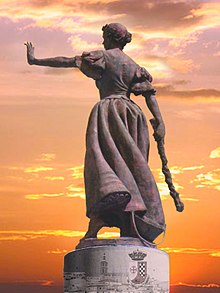Juana Galán

Juana Galán , called La Galana (* 1787 in Valdepeñas , † September 24, 1812 in Valdepeñas), was a Spanish guerrilla fighter in the Spanish War of Independence from 1808 - 1814.
biography
Juana Galán was the oldest of seven siblings. The family ran a large house with an inn and tavern at the entrance to Valdepeñas. She was considered the best informed woman in the village because she worked at this general meeting place.
On June 6, 1808, the population in the Contienda de Valdepeñas fought against a French force who wanted to force the march through the place. Since there were not enough men capable of fighting, Juana Galán encouraged women to fight. The women poured water and boiling oil from the windows on the soldiers, armed themselves with clubs, and went out into the streets to fight the French cavalry . The French, for their part, set fire to the surrounding houses. The local authority finally negotiated with the French and released the way under certain conditions. The troops, however, decided not to continue the march the next day because they lacked ammunition and instead withdrew. Thanks to these events, the troops arrived late in the Battle of Bailén , which ended in the victory of the Spanish.
On May 2, 1810, the second anniversary of the declaration of war, Juana Galán married Bartolomé Ruiz de Lerma from Valdepeñas. On September 24, 1812, she died giving birth to their second daughter. On the same day the Mancha declared itself independent, combined with a triumphant entry of the fighters of Francisco Abad Moreno into Valdepeñas.
reception
In Valdepeñas, you are the historical embodiment of resistance, heroism, bravery and patriotism. It is represented in numerous works of art in the city. She is usually shown standing, holding a club in her right hand and grabbing a French soldier on the left. It is often featured in patriotic theatrical dramas depicting the Battle of Bailén and the Battle of Valdepeñas. In a play on the occasion of the 100th anniversary of the war, the theater group La Recua from Toledo symbolically staged them: their stage person traveled to the places of legendary executions.
The following speculations have grown up around them:
- She suffered from dementia or schizophrenia after the fight.
- You have had a love affair with the famous guerrilla Francisco Abad Moreno.
- She met Agustina de Aragón in 1810 .
In 2011 her life became the subject of the novel La Galana by Carlos Isidro Muñoz de la Espada Galán.
Individual evidence
- ↑ Guerra de la independencia (1808-1814). Cierre del paso de Despeñaperros (5 and 6 de junio de 1808). In: Historia militar de España. Archived from the original on March 13, 2016 ; Retrieved January 3, 2019 (Spanish).
- ^ Carlos Isidro Muñoz de la Espada Galán: La Galana . Ediciones Atlantis, 2011, ISBN 978-84-15449-11-9 (Spanish).
Web links
| personal data | |
|---|---|
| SURNAME | Galan, Juana |
| ALTERNATIVE NAMES | La Galana |
| BRIEF DESCRIPTION | Spanish guerrilla fighter in the Spanish War of Independence |
| DATE OF BIRTH | 1787 |
| PLACE OF BIRTH | Valdepeñas (Ciudad Real) |
| DATE OF DEATH | September 24, 1812 |
| Place of death | Valdepeñas (Ciudad Real) |
